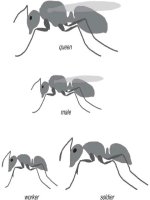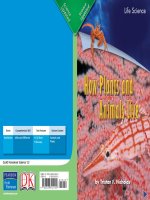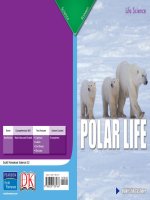3 2 how animals live (life science)
Bạn đang xem bản rút gọn của tài liệu. Xem và tải ngay bản đầy đủ của tài liệu tại đây (3.88 MB, 14 trang )
Life Science
by Lisa Oram
Genre
Nonfiction
Comprehension Skill
Sequence
Text Features
• Captions
• Glossary
Science Content
Animals
Scott Foresman Science 3.2
ISBN 0-328-13811-8
ì<(sk$m)=bdib b< +^-Ä-U-Ä-U
Vocabulary
What did you learn?
adaptation
hibernate
1. What are animals that do not have backbones
called?
by Lisa Oram
inherited
2. Name two animals that are vertebrates.
larva
3. What does camouflage do?
migrate
4.
You have read about
behaviors that help animals. Write to explain
how an animal’s instincts and learned behaviors
affect its survival. Use examples from the book
as you write.
5.
Sequence Name the four steps of a
butterfly’s life cycle in order.
How Animals Live
pupa
trait
vertebrate
Photographs: Every effort has been made to secure permission and provide appropriate credit for
photographic material. The publisher deeply regrets any omission and pledges to correct errors called to its
attention in subsequent editions.Unless otherwise acknowledged, all photographs are the property of Scott
Foresman, a division of Pearson Education.
Photo locators denoted as follows: Top (T), Center (C), Bottom (B), Left (L), Right (R) Background (Bkgd)
Cover: ©Barbara Von Hoffmann/Animals Animals/Earth Scenes
Title Page: ©The Image Bank/Getty Images; 6 ©DK Images 8 (Bkgd) ©George Grall/NGS Image
Collection, (BR) ©Danny Lehman/Corbis; 9 ©Robert Pickett/Corbis; 12 (T, CL) ©DK Images, (BL) ©Breck
P. Kent/Animals Animals/Earth Scenes; 13 (TR) ©Carolina Biological Supply Company/Phototake, (BR)
©Randy M. Ury/Corbis; 14 ©Frans Lanting/Minden Pictures; 15 (TR) ©Kevin Schafer/Corbis, (CR) ©Gary
W. Carter/Corbis, (BR) ©DK Images; 16 (CL) ©Rolf Kopfle/Bruce Coleman Inc., (CR) ©Michael Quinton/
Minden Pictures, (BR) ©The Image Bank/Getty Images; 17 (T) ©Suzanne L. & Joseph T. Collins/Photo
Researchers, Inc., (BL) ©Tim Laman/NGS Image Collection, (BL) ©E. R. Degginger/Bruce Coleman Inc.;
18 ©Jeff L. Lepore/Photo Researchers, Inc.; 19 ©Gerry Ellis/Minden Pictures; 21 ©James L. Amos/Photo
Researchers, Inc.
ISBN: 0-328-13811-8
Copyright © Pearson Education, Inc.
All Rights Reserved. Printed in the United States of America. This publication is
protected by Copyright and permission should be obtained from the publisher prior
to any prohibited reproduction, storage in a retrieval system, or transmission in any
form by any means, electronic, mechanical, photocopying, recording, or likewise. For
information regarding permissions, write to: Permissions Department, Scott Foresman,
1900 East Lake Avenue, Glenview, Illinois 60025.
3 4 5 6 7 8 9 10 V010 13 12 11 10 09 08 07 06 05
Animals get oxygen from air or water. Many land
How are animals grouped?
animals breathe with lungs. Many water animals
What All Animals Need
breathe with gills.
Almost all animals need water, food, oxygen, and
shelter to live.
Animals get water from drinking or eating food.
Animals need shelter. Some animals find or build
shelter. Other animals grow hard shells to protect
themselves.
They get food by eating plants or other animals.
2
3
Ways Of Grouping Animals
Animals can be grouped by their traits. A trait
is the way an animal looks or acts. Animals get
traits from their parents. Traits can be used to group
animals.
Fish are vertebrates that live in water. Fish have
scaly skin. They breathe through gills.
Amphibians are vertebrates. They can live in water.
They can also live on land. Amphibians breathe
through gills when they are young. They also get
oxygen through their skin. As they grow, they develop
Animals with Backbones
lungs. Toads and frogs are amphibians.
Animals with backbones belong to one group.
A vertebrate is an animal with a backbone.
Vertebrates’ backbones grow as they get older. Fish,
A frog is an
amphibian.
snakes, and cats are all vertebrates. Vertebrates can
look very different.
Fish are
vertebrates.
This lynx is a
vertebrate.
4
5
Reptiles are vertebrates with scaly skin. Crocodiles
Mammals are vertebrates. Mammals have hair on
and alligators are reptiles. They breathe through
their bodies. This keeps them warm. They breathe
lungs. Snakes, lizards, and turtles are reptiles too.
through lungs. Mammals feed milk to their young.
Birds are vertebrates that breathe through lungs.
They have bills instead of teeth. Wings and light bones
help most birds fly. Their feathers keep them warm.
These koalas
are mammals.
These owls and this snake
are both vertebrates.
How are they different?
6
7
Animals Without Backbones
Most animals do not have backbones. These
animals are called invertebrates.
Most invertebrates do not grow as big as vertebrates.
Invertebrates make up most of the animals on Earth.
There are many more invertebrates than vertebrates.
Sea jellies, butterflies, and clams are all invertebrates.
Worms are invertebrates. They have long, soft
bodies. Worms do not have legs. They slide and wiggle
through the ground to move. Earthworms live in soil
and keep it healthy.
Insects, spiders, and crabs are arthropods.
The body of this sea
jelly is soft. Most of
it is water.
Arthropods are the largest group of invertebrates.
They have skeletons on the outsides of their bodies.
They also have legs with joints.
This snail is a mollusk.
Many mollusks have
hard shells and soft
bodies.
A butterfly is an
invertebrate.
8
Does this worm
have a backbone?
9
A Butterfly’s Life Cycle
How do animals grow
and change?
A butterfly begins life as an egg. A caterpillar,
or larva, hatches from the egg. A larva is a young
insect. The caterpillar eats and grows. Soon it spins a
Life Cycles
hard covering, or chrysalis, around itself. The larva
All animals grow and change over time. These
is now a pupa. It grows and changes. It becomes an
changes are called a life cycle. Animals start as an
adult butterfly. The butterfly breaks open the chrysalis
egg. Some animals lay their eggs. The eggs hatch
and crawls out. Butterflies lay eggs. After laying eggs,
when the young animals are ready. Other animals
butterflies die. Then the life cycle of the butterfly
grow from eggs inside their mother’s body. Those
is complete.
mothers give birth to live young. Some animals begin
life looking like their parents. Others look different.
A butterfly changes
a lot during its life.
Laying new eggs
Pupa
Butterfly
Larva
Egg
10
11
Some Vertebrate Life Cycles
A Mammal’s Life Cycle
Vertebrate life cycles can be different. Some
Most mammals develop inside
vertebrates go through many changes as they
their mother’s body. Young
grow. Others hardly change at all.
mammals drink milk from
their mothers. They have
A Frog’s Life Cycle
either hair or fur. Many young
Frogs go through many changes.
mammals look a lot like their
They start life in the water as
parents soon after they are born.
eggs. Tadpoles hatch from
This panda cub looks
a lot like its parents.
the eggs. They breathe with
gills and live underwater.
Tadpole
The tadpole grows
lungs and legs, and
turns into an adult.
Eggs
Most adult frogs live
near water.
Adult frog
A frog must change a
lot before it looks like
its parents.
12
Growing
tadpole
13
How do adaptations help
animals?
Adaptations
An adaptation is a trait that helps an animal
Adaptations for Getting Food
Animals have many adaptations for getting food.
An eagle’s feet can hold food while it flies.
Deer have sharp front teeth to help cut plants. They
also have flat back teeth to help grind plants.
A cardinal eats seeds. It uses its short, strong bill
meet its needs in the place where it lives. Adaptations
to break open the seeds. Each adaptation fits an
are inherited, or passed on, from parents to
animal’s needs.
their young.
A pelican is a bird that
lives near water. It needs
to swim to find food.
A pelican’s webbed
feet help it swim.
Its webbed feet are
Flamingos filter food
from the water.
an adaptation.
A pelican has a
special bill. It acts
like a net to help the
pelican catch fish.
Cardinals break
open seeds.
These birds all have
different bills. They all
eat something different.
Warblers pick out insects.
14
15
Adaptations for Protection
Some animals have spikes or horns for protection.
All animals need ways to stay safe. Some animals
The porcupine has hundreds of sharp quills. This
adaptation is called armor.
can quickly run away from enemies.
Other animals are colored in a way that makes
them hard to see. This is called camouflage.
Camouflage helps some animals stay alive.
Other animals mimic, or look like, a different
animal. The king snake mimics the coral snake,
which is poisonous. Other animals then avoid the
king snake.
King snake
Arctic fox
Fish
Crab spider
Do these animals have
camouflage? Yes! They
are hard to see.
16
Coral snake
How have these
animals protected
themselves?
Cassowary
17
Behaviors That Help Animals
Instincts
Behaviors are things that animals do. Some
A behavior an animal is born with is an instinct.
behaviors are inherited. Other behaviors that animals
Instincts help some animals survive during winter.
need are learned. These behaviors can be learned
Many animals know to migrate, or move long
from parents or other animals. The ability to learn is
distances, to find more food.
inherited, however.
Other animals know to hibernate or sleep,
during winter. Their bodies slow down so they don’t
need much food.
These geese
are migrating.
Learning
Animals learn some behaviors by watching
parents or other animals. Adult chimpanzees show
their young how to find and get food. The young
learn which foods are good to eat.
This young chimpanzee is
learning how to find food.
These bats are
hibernating.
18
19
How are animals from the
past like today’s animals?
Animals That Lived Long Ago
Ancient Insects
Tiny insects caught in sticky tree sap have become
fossils. Fossils of larger animals, such as saber-toothed
tigers, have been found in tar pits.
Signs of past life are called fossils. A fossil can be an
animal track or print hardened into rock. This is called
a fossil mold. A fossil mold can be filled with rock.
Then it is called a cast.
Trilobite fossil
cast
Spider trapped in amber
Fossil cast of a
dinosaur skull
Bird-like dinosaur
fossil cast
We can learn about animals
from the past by studying fossils,
fossil molds, and fossil casts.
20
21
How Animals Today Compare to
Those of Long Ago
Fossils help people learn about animals and plants
that lived long ago. They help us tell what Earth was
like and how it has changed. Some animals that lived
in the past are extinct. That means they no longer live
on Earth.
Animals have found ways to live in many places
on Earth. Their adaptations keep them alive. Animals
have found incredible ways to keep living!
This T. rex
dinosaur is
extinct.
This collared lizard
looks like dinosaurs
from long ago. But
it is much smaller.
22
23
Glossary
Vocabulary
What did you learn?
adaptation
adaptation
a trait that helps an animal survive in
hibernate
the place where it lives
1. What are animals that do not have backbones
called?
hibernate
inherited
to spend the winter in a way that
2. Name two animals that are vertebrates.
doesn’t require a lot of food
3. What does camouflage do?
larva
inherited
passed on from parents to their young
larva
the early form of an insect
migrate
to move from one region to another
trait
when the seasons change
vertebrate
pupa
the stage of an insect’s life between
migrate
pupa
larva and adult
trait
the way an animal looks or acts
Photographs: Every effort has been made to secure permission and provide appropriate credit for
photographic material. The publisher deeply regrets any omission and pledges to correct errors called to its
attention in subsequent editions.Unless otherwise acknowledged, all photographs are the property of Scott
Foresman, a division of Pearson Education.
Photo locators denoted as follows: Top (T), Center (C), Bottom (B), Left (L), Right (R) Background (Bkgd)
Cover: ©Barbara Von Hoffmann/Animals Animals/Earth Scenes
Title Page: ©The Image Bank/Getty Images; 6 ©DK Images 8 (Bkgd) ©George Grall/NGS Image
Collection, (BR) ©Danny Lehman/Corbis; 9 ©Robert Pickett/Corbis; 12 (T, CL) ©DK Images, (BL) ©Breck
P. Kent/Animals Animals/Earth Scenes; 13 (TR) ©Carolina Biological Supply Company/Phototake, (BR)
©Randy M. Ury/Corbis; 14 ©Frans Lanting/Minden Pictures; 15 (TR) ©Kevin Schafer/Corbis, (CR) ©Gary
W. Carter/Corbis, (BR) ©DK Images; 16 (CL) ©Rolf Kopfle/Bruce Coleman Inc., (CR) ©Michael Quinton/
Minden Pictures, (BR) ©The Image Bank/Getty Images; 17 (T) ©Suzanne L. & Joseph T. Collins/Photo
Researchers, Inc., (BL) ©Tim Laman/NGS Image Collection, (BL) ©E. R. Degginger/Bruce Coleman Inc.;
18 ©Jeff L. Lepore/Photo Researchers, Inc.; 19 ©Gerry Ellis/Minden Pictures; 21 ©James L. Amos/Photo
Researchers, Inc.
vertebrate
an animal with a backbone
ISBN: 0-328-13811-8
Copyright © Pearson Education, Inc.
All Rights Reserved. Printed in the United States of America. This publication is
protected by Copyright and permission should be obtained from the publisher prior
to any prohibited reproduction, storage in a retrieval system, or transmission in any
form by any means, electronic, mechanical, photocopying, recording, or likewise. For
information regarding permissions, write to: Permissions Department, Scott Foresman,
1900 East Lake Avenue, Glenview, Illinois 60025.
3 4 5 6 7 8 9 10 V010 13 12 11 10 09 08 07 06 05
24
4.
You have read about
behaviors that help animals. Write to explain
how an animal’s instincts and learned behaviors
affect its survival. Use examples from the book
as you write.
5.
Sequence Name the four steps of a
butterfly’s life cycle in order.









